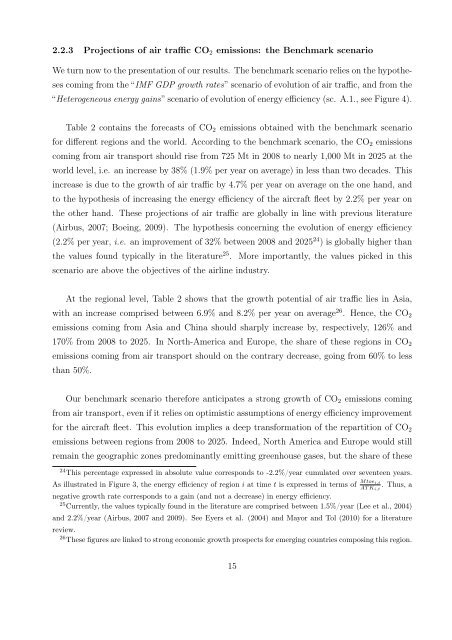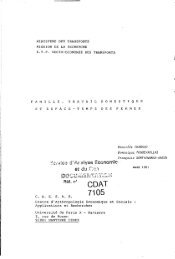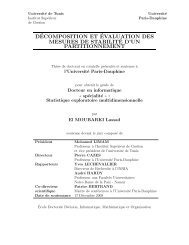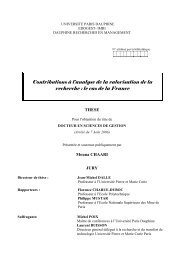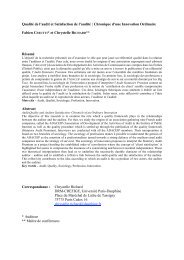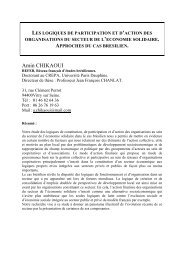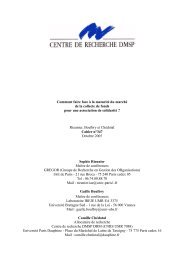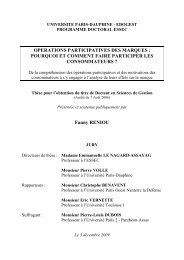12-02-Cahier-R- ... e-Chevallier-Gastineau.pdf - Base ...
12-02-Cahier-R- ... e-Chevallier-Gastineau.pdf - Base ...
12-02-Cahier-R- ... e-Chevallier-Gastineau.pdf - Base ...
You also want an ePaper? Increase the reach of your titles
YUMPU automatically turns print PDFs into web optimized ePapers that Google loves.
2.2.3 Projections of air traffic CO2 emissions: the Benchmark scenario<br />
We turn now to the presentation of our results. The benchmark scenario relies on the hypothe-<br />
ses coming from the “IMF GDP growth rates” scenario of evolution of air traffic, and from the<br />
“Heterogeneous energy gains” scenario of evolution of energy efficiency (sc. A.1., see Figure 4).<br />
Table 2 contains the forecasts of CO2 emissions obtained with the benchmark scenario<br />
for different regions and the world. According to the benchmark scenario, the CO2 emissions<br />
coming from air transport should rise from 725 Mt in 2008 to nearly 1,000 Mt in 2<strong>02</strong>5 at the<br />
world level, i.e. an increase by 38% (1.9% per year on average) in less than two decades. This<br />
increase is due to the growth of air traffic by 4.7% per year on average on the one hand, and<br />
to the hypothesis of increasing the energy efficiency of the aircraft fleet by 2.2% per year on<br />
the other hand. These projections of air traffic are globally in line with previous literature<br />
(Airbus, 2007; Boeing, 2009). The hypothesis concerning the evolution of energy efficiency<br />
(2.2% per year, i.e. an improvement of 32% between 2008 and 2<strong>02</strong>5 24 ) is globally higher than<br />
the values found typically in the literature 25 . More importantly, the values picked in this<br />
scenario are above the objectives of the airline industry.<br />
At the regional level, Table 2 shows that the growth potential of air traffic lies in Asia,<br />
with an increase comprised between 6.9% and 8.2% per year on average 26 . Hence, the CO2<br />
emissions coming from Asia and China should sharply increase by, respectively, <strong>12</strong>6% and<br />
170% from 2008 to 2<strong>02</strong>5. In North-America and Europe, the share of these regions in CO2<br />
emissions coming from air transport should on the contrary decrease, going from 60% to less<br />
than 50%.<br />
Our benchmark scenario therefore anticipates a strong growth of CO2 emissions coming<br />
from air transport, even if it relies on optimistic assumptions of energy efficiency improvement<br />
for the aircraft fleet. This evolution implies a deep transformation of the repartition of CO2<br />
emissions between regions from 2008 to 2<strong>02</strong>5. Indeed, North America and Europe would still<br />
remain the geographic zones predominantly emitting greenhouse gases, but the share of these<br />
24 This percentage expressed in absolute value corresponds to -2.2%/year cumulated over seventeen years.<br />
As illustrated in Figure 3, the energy efficiency of region i at time t is expressed in terms of Mtoei,t<br />
. Thus, a<br />
ATKi,t<br />
negative growth rate corresponds to a gain (and not a decrease) in energy efficiency.<br />
25 Currently, the values typically found in the literature are comprised between 1.5%/year (Lee et al., 2004)<br />
and 2.2%/year (Airbus, 2007 and 2009). See Eyers et al. (2004) and Mayor and Tol (2010) for a literature<br />
review.<br />
26 These figures are linked to strong economic growth prospects for emerging countries composing this region.<br />
15


